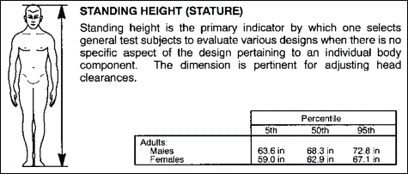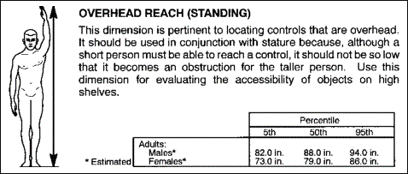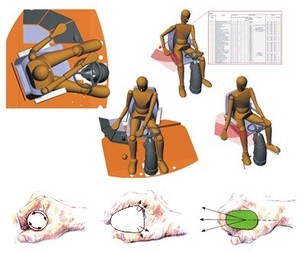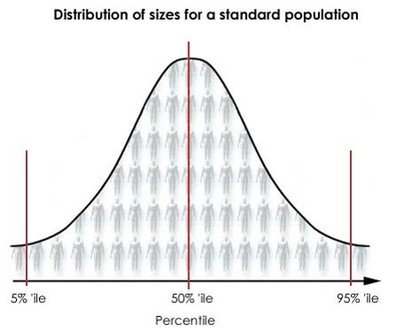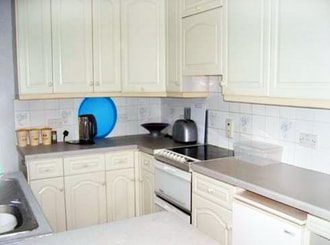1.1 a Anthropometrics
|
Today, anthropometry plays an important role in industrial design, clothing design, ergonomics and architecture where statistical data about the distribution of body dimensions in the population are used to optimize products. Changes in lifestyles, nutrition, and ethnic composition of populations lead to changes in the distribution of body dimensions (e.g. the obesity epidemic), and require regular updating of anthropometric data collections.
Anthropometrics: The aspect of ergonomics that deals with body measurements, particularly those of size, strength and physical capacity.
|
It is therefore that part of ergonomics which deals with body measurement, particularly size, strength and physical capacity. It was developed by Henry Dreyfus in the USA in the 1940/50’s. To be universally effective, anthropometrics are used to describe the “user” or “target population” for a particular product. Having data available on these groups takes the guesswork out of designing. Basic statistical information is used to interpret these data, e.g. Percentile study.
|
Anthropometrics: The study of the human body and its movements, and often involves research into measurements of body parts. The data that designers and researchers gather often helps them to determine the size of certain parts of a product, to ensure comfortable and efficient use. A number of areas and factors must be considered when planning size and shape of products, especially those related to posture and movement.
Anthropometric data sets can vary significantly between populations. Particularly in the fashion industry, the variance in these data sets impacts the size range of clothes for particular markets.
|
Anthropometric data can be considered in the following ways.
- Static and dynamic data
- Structural and functional data
|
|
|
Ergonomics: Also known as comfort design, and often refers to the function of a product, and aims to achieve the most efficient and comfortable interaction between a product, and its user.
Research
Primary Research: Is new research that a designer completes first hand. In terms of Anthropometry, a designer may conduct primary research to measure a range of people’s hands, to find out averages. Research done first hand, therefore likely to be reliable. Secondary Research: Is research that others would have collected beforehand, and designers can collect from a large database of Anthropometric measurements. Saves time and cost for a designer or a manufacturer, however may be outdated or unreliable. |
|
|
Percentiles and Percentile Ranges
It is nearly impossible for a designer to design a product that is going to suit everybody on the market, and the idea of ‘one size fits all’, is nearly impossible to adhere to, due to the many different shapes and sizes of people that are in a market place. Designers therefore look to design for users that are categorised within what’s known as the 5th – 95th Percentile. For example; If a chair was made for 100 people, Statistically, it would be anthropometrically suited to 90 of the people who purchased it, because on average, 5% of people would be below average size, and 5% of people would be above average size |
|
|
This graph shows how the distribution of sizes for an average population varies. The 50%'ile, is the 'average' person. In most population's, people are around the 'average' size. As you move outwards to either extreme, the number of the population who are that big rapidly drops off. This graph shows a population with an equal distribution. But in most populations the 50th%'ile will be skewed toward either the lower end of higher end.
For example the average size of a UK man is around 5' 10". Up to 6 foot, a large number of the population are that big. But as you move toward 6' 5" to 7' the numbers rapidly drop off. Sizes over the 95th %ile are rare and therefore most tables don't show these extremes. It is important to realise that most anthropometric studies are biased. The early surveys generally looked at 'European/African descendant males, because that was the intake of the US army. |
Describe a design context where the 50th percentile has been used. For example, height of a desk.
- Washing machines and cookers are designed around the 50th percentile so they are all a standard height regardless of the brand and can be used by short and tall people.
- Most ATMs are designed with the average or 50th percentile user in mind.
Clearance, Reach and Adjustability
Human dimensions are not always in proportion, which can often be a problem for designers, especially when accounting for adjustability. Just because a person is tall, does not necessarily mean that the rest of their body will be in proportion, for example a tall person can have small arms, which means their ‘work space envelope’ is likely to be small
|
Using the office chair example again, the image above shows a user sitting on an adjustable office chair, which makes life much easier for a designer, as they are able to include more consumers within a market place
|




